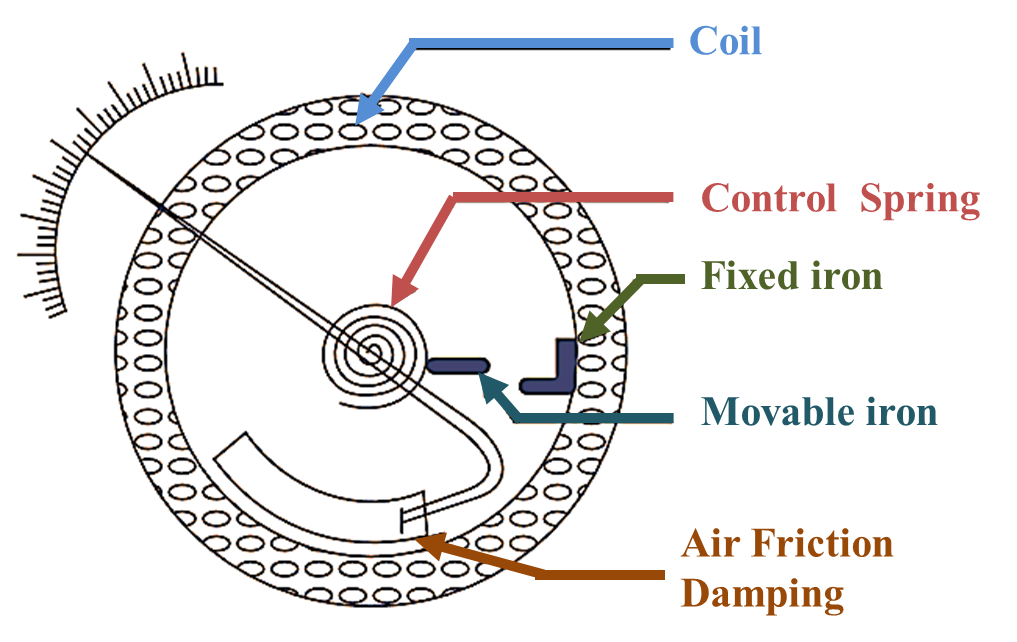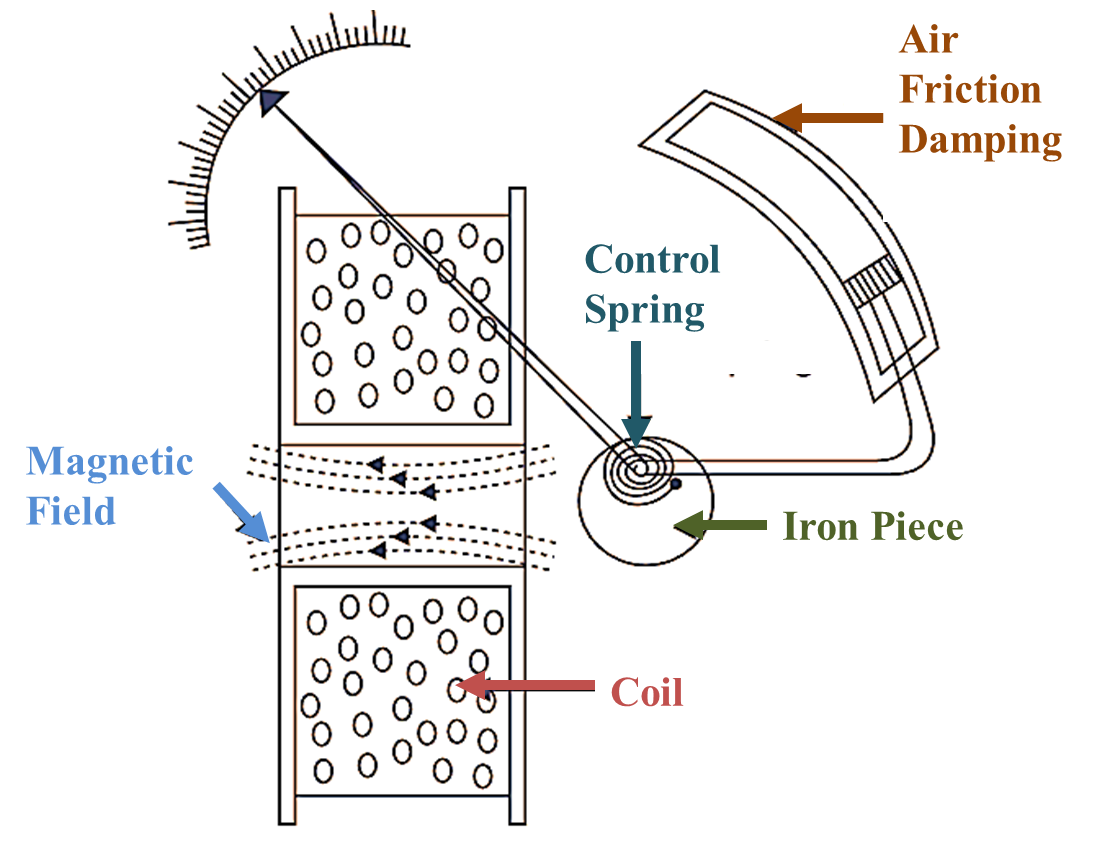In Moving Iron instruments (or MI Instruments), an iron piece moves, when repelled (or attracted) by the magnetic field of a coil. With the moving piece, a pointer is attached which shows deflection on a calibrated scale. These instruments are simple, cheap and reasonably accurate and can be used for ac/dc measurements hence find extensive use in practical fields.
Types of Moving Iron Instrument
These are of two types:
- Repulsion type.
- Attraction type.
Repulsion Type Moving Iron Instrument
In this instrument, there are two pieces of iron placed in the magnetic field of a coil. One of the pieces is fixed while the other is movable with which a light aluminium pointer is attached (see Figure 1).
When there is no current in the coil, the two iron pieces are almost touching each other and the pointer rests at the zero position of the scale. When the current (or a current proportional to the voltage) to be measured is passed through the coil, a magnetic field is produced and the two iron pieces are magnetized in the same direction. The free piece experiences a repulsive force from the fixed piece and moves with the result, that the pointer attached with the moving piece shows deflection on the scale. The pointer comes to rest when repulsive torque (deflecting force) and the controlling torque provided by spring become equal. The damping is provided by air friction (pneumatic) method. Eddy current dumping is not possible as it will need a permanent magnet which will affect the magnetic field of the coil.

Fig. 1. Repulsion type Moving Iron Instrument.
Deflecting Torque Equation
The deflecting torque depends upon the repulsive force between the iron pieces.
Td ∝ I2
The pointer rests where deflecting torque equals the controlling torque
Td = TC
But controlling torque,
TC ∝ θ (θ is the deflection of the pointer)
Thus,
θ ∝ I2
Thus scale of these instruments is not uniform, and is crowded in the beginning. However a uniform scale can be obtained by proper designing of the iron pieces. If ac flows through the coil, the magnetic field will be reversed and so the force on both the pieces. Hence, the instrument can be used for dc/ac measurements.
Attraction Type Moving Iron Instrument
In this instrument there is only one piece of iron under the influence of magnetic field of the coil. The iron piece, which is movable may be of any shape, but usually OVAL shape is preferred, as it gives uniform scale to the instrument. To the iron piece, a pointer is attached, which can move on a calibrated scale. See Fig. 2.

Fig. 2. Attraction type Moving Iron Instrument.
When the current flows through the coil, a magnetic field is developed and the iron piece experiences an attractive force and moves into the coil: as a result the pointer also moves on the scale. When the instrument is removed from the circuit, no current flows through the coil no magnetic field and the iron piece comes out of the coil to its original position. The controlling torque may be provided by spring or by gravity weight. The damping is provided through pneumatic (air friction) method.
Deflecting Torque Equation
The deflecting torque depends upon the attractive force (or current in coil) on the iron piece.
Td ∝ I2
The pointer will stop when
Td = TC
But controlling torque,
TC ∝ θ (θ is the deflection of the pointer)
Thus,
θ ∝ I2
Thus, scale of this instrument will also be non-uniform and crowded in the beginning. If ac flows through the coil its magnetic field will be reversed and so the direction of force on the piece. hence the instrument can be used for ac/dc measurements.
Advantages of Moving Iron Instrument
- These instruments are simple in construction and cheaper in cost.
- They can be used for ac as well dc measurements.
- They have a high starting torque.
- They can withstand overload momentarily.
Disadvantages of Moving Iron Instrument
- They have a non-uniform scale and hence it is difficult to read them correctly.
- They suffer from hysteresis loss in the iron piece.
- Due to iron, they are heavy weight and consume more power.
- They are not very sensitive.
- During ac measurements, error is introduced due to change in the frequency.
Errors in Moving Iron Instrument
- The first source of error is due to hysteresis effect in the moving soft iron piece.
- The stray magnetic fields around the instrument badly affect the accuracy. if the instrument has not been provided proper magnetic screening.
- During ac measurement, change in frequency causes change in the impedance of the coil and thus an error is introduced.
Note that, first two errors are present during ac as well as dc measurements while the third error will occur only in ac measurements.
Range of Moving Iron Instrument
- Ammeter: From 0 — 800 A (with shunt)
- Voltmeter: From 0 — 800 V (with multiplier)